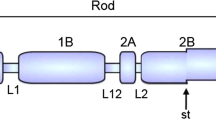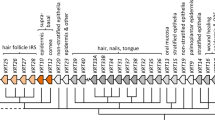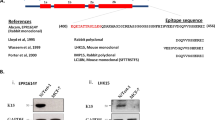Abstract
Among the 26 human type II keratins, K78 is the only one that has not yet been explored with regard to its expression characteristics. Here, we show that, at both the transcriptional and translational levels, K78 is strongly expressed in the basal and parabasal cell layers with decreasing intensity in the lower suprabasal cells of keratinising and non-keratinising squamous epithelia and keratinocyte cultures. The same pattern has been detected at the transcriptional level in the corresponding mouse epithelia. Murine K78 protein, which contains an extraordinary large extension of its tail domain, which is unique among all known keratins, is not detectable by the antibody used. Concomitant studies in human epithelia have confirmed K78 co-expression with the classical basal keratins K5 and K14. Similarly, K78 co-expression with the differentiation-related type I keratins K10 (epidermis) and K13 (non-keratinising epithelia) occurs in the parabasal cell layer, whereas that of the corresponding type II keratins K1 (epidermis) and K4 (non-keratinising epithelia) unequivocally starts subsequent to the respective type I keratins. Our data concerning K78 expression modify the classical concept of keratin pair K5/K14 representing the basal compartment and keratin pairs K1/K10 or K4/K13 defining the differentiating compartment of stratified epithelia. Moreover, the K78 expression pattern and the decoupled K1/K10 and K4/K13 expression define the existence of a hitherto unperceived early differentiation stage in the parabasal layer characterized by K78/K10 or K78/K13 expression.






Similar content being viewed by others
References
Ansell D (2012) The role of hair follicles in cutaneous wound healing. PhD thesis. University of Manchester, Cell Biology, Faculty of Life Sciences
Blumenberg M (2000) Transcriptional control of keratin expression. Madame Curie Bioscience database (internet). NCBI Bookshelf, http://www.ncbi.nlm.nih.gov/books/NBK6213/
Boukamp P, Petrussevska RT, Breitkreutz D, Hornung J, Markham A, Fusenig NE (1988) Normal keratinization in a spontaneously immortalized aneuploid human keratinocyte cell line. J Cell Biol 106:761–771
Bray DJ, Walsh TR, Noro MG, Notman R (2015) Complete structure of an epithelial keratin dimer: implications for intermediate filament assembly. PLoS One 10:e0132706. doi:10.1371/journal.pone.0132706
Bundela S, Sharma A, Bisen PS (2014) Potential therapeutic targets for oral cancer: ADM, TP53, EGFR, LYN, CTLA4, SKIL, CTGF, CD70. PLoS One 9:e102610
Byrne C, Tainsky M, Fuchs E (1994) Programming gene expression in developing epidermis. Development 120:2369–2383
Chen C, Méndez E, Houk J, Fan W, Lohavanichbutr P, Doody D, Yueh B, Futran ND, Upton M, Farwell DG, Schwartz SM, Zhao LP (2008) Gene expression profiling identifies genes predictive of oral squamous cell carcinoma. Cancer Epidemiol Biomarkers Prev 17:2152–2162
Crane HR (1950) Principles and problems of growth. Sci Month 70:376–389
Feng X, Coulombe PA (2015) A role for disulfide bonding in keratin intermediate filament organization and dynamics in skin keratinocytes. J Cell Biol 209:59–72
Fessing MY, Mardaryev AN, Gdula MR, Sharov AA, Sharova TY, Rapisarda V, Gordon KB, Smorodchenko AD, Poterlowicz K, Ferone G, Kohwi Y, Missero C, Kohwi-Shigematsu T, Botchkarev VA (2011) p63 regulates Satb1 to control tissue-specific chromatin remodelling during development of the epidermis. J Cell Biol 194:825–839
Fine JD, Bruckner-Tuderman L, Eady RA, Bauer EA, Bauer JW, Has C, Heagerty A, Hintner H, Hovnanian A, Jonkman MF, Leigh I, Marinkovich MP, Martinez AE, McGrath JA, Mellerio JE, Moss C, Murrell DF, Shimizu H, Uitto J, Woodley D, Zambruno G (2014) Inherited epidermolysis bullosa: updated recommendations on diagnosis and classification. J Am Acad Dermatol 70:1103–1126
Fischer H, Langbein L, Reichelt J, Praetzel-Wunder S, Buchberger M, Ghannadan M, Tschachler E, Eckhart L (2014) Loss of keratin K2 expression causes aberrant aggregation of K10, hyperkeratosis and inflammation. J Invest Dermatol 134:2579–2588
Fraser RDB, Parry DAD (2014) Keratin intermediate filaments: differences in the sequences of the Type I and Type II chains explain the origin of the stability of an enzyme-resistant four-chain fragment. J Struct Biol 185:317–326
Garritano S, Inga A, Gemignani F, Landi S (2013) More targets, more pathways and more clues for mutant p53. Oncogenesis 2:e54. doi:10.1038/oncsis.2013.15
Griffiths G, Lucocq JM (2014) Antibodies for immunolabeling by light and electron microscopy: not for the faint hearted. Histochem Cell Biol 142:347–360
Hesse M, Magin TM, Weber K (2001) Genes for intermediate filament proteins and the draft sequence of the human genome: novel keratin genes and a surprisingly high number of pseudogenes related to keratin genes 8 and 18. J Cell Sci 114:2569–2575
Hesse M, Zimek A, Weber K, Magin TM (2004) Comprehensive analysis of keratin gene clusters in humans and rodents. Eur J Cell Biol 83:19–26
Holbrook KA (2006) Embryogenesis of the skin. In: Irvine AD, Hoeger PH, Yan AC (eds) Harper’s textbook of pediatric dermatology, 2nd edn. Wiley, Hoboken, pp 21-241
Holbrook KA, Odland GF (1975) The fine structure of developing human epidermis: light, scanning, and transmission electron microscopy of the periderm. J Invest Dermatol 65:16–38
Huchon D, Chevret P, Jordan U, Kilpatrick CW, Ranwez V, Jenkins PD, Brosius J, Schmitz J (2007) Multiple molecular evidences for a living mammalian fossil. Proc Natl Acad Sci U S A 104:7495–7499
Kiba T, Kintaka Y, Suzuki Y, Ishizuka N, Ishigaki Y, Inoue S (2010) Gene expression profiling in rat pancreas after ventromedial hypothalamic lesioning. Pancreas 39:627–632
Kiran KC, Rothenberg E, Sherrill JD (2015) In vitro model for studying esophageal epithelial differentiation and allergic inflammatory responses identifies keratin involvement in eosinophilic esophagitis. PLoS One 10:e0127755, doi:10.1371/ journal phone 012775
Kumar S, Hedges SB (1998) A molecular timescale for vertebrate evolution. Nature 392:917–920
Kunisada M, Cui CY, Piao Y, Ko MS, Schlessinger D (2009) Requirement for Shh and Fox family genes at different stages in sweat gland development. Hum Mol Genet 18:1769–1778
Lane EB, McLean WH (2004) Keratins and skin disorders. J Pathol 204:355–366
Langbein L, Schweizer J (2013) The keratins of the human hair follicle. In: Camacho FM, Tosti A, Price VH, Randall VA (eds) Montagna Tricología Enfermedades del folículo pilosebáceo. Editorial Aula Medica, Madrid, pp 73–108
Langbein L, Heid HW, Moll I, Franke WW (1993) Molecular characterization of the body site-specific human cytokeratin 9—cDNA cloning, amino acid sequence and tissue specificity of gene expression. Differentiation 55:57–73
Langbein L, Spring H, Rogers MA, Praetzel S, Schweizer J (2004) Hair keratins and hair follicle-specific epithelial keratins. Methods Cell Biol 78:413–451
Langbein L, Rogers MA, Praetzel S, Cribier B, Peltre B, Gassler N, Schweizer J (2005) Characterization of a novel human type II epithelial keratin K1b, specifically expressed in eccrine sweat glands. J Invest Dermatol 125:428–444
Langbein L, Rogers MA, Praetzel-Wunder S, Helmke B, Schirmacher P, Schweizer J (2006) K25 (K25irs1), K26 (K25irs2), K27 (K25irs3) and K28 (K25irs4) represent the type I inner root sheath (IRS) keratins of the human hair follicle. J Invest Dermatol 126:2377–2386
Langbein L, Eckhart L, Rogers MA, Praetzel-Wunder S, Schweizer J (2010) Against the rules: human keratin K80: two functional alternative splice variants, K80 and K80.1, with special cellular localization in a wide range of epithelia. J Biol Chem 285:36909–36921
Langbein L, Reichelt J, Eckhart L, Praetzel-Wunder S, Kittstein W, Gassler N, Schweizer J (2013) New facets of keratin K77: interspecies variations of expression and different intracellular location in embryonic and adult skin of man and mouse. Cell Tissue Res 354:793–812
Lee CH, Coulombe PA (2009) Self-organization of keratin intermediate filaments into cross-linked networks. J Cell Biol 186:409–421
Lu H, Hesse M, Peters B, Magin TM (2005) Type II keratins precede type I keratins during early embryonic development. Eur J Cell Biol 84:709–718
Lu H, Zimek A, Chen J, Hesse M, Büssow H, Weber K, Magin TM (2006) Keratin 5 knockout mice reveal plasticity of keratin expression in the corneal epithelium. Eur J Cell Biol 85:803–811
Micallef L, Belaubre F, Pinon A, Jayat-Vignoles C, Delage C, Charveron M, Simon A (2008) Effects of extracellular calcium on the growth-differentiation switch in immortalized keratinocyte HaCaT cells compared with normal human keratinocytes. Exp Dermatol 18:143–151
Micallef L, Battu S, Pinon A, Cook-Moreau J, Cardot PJ, Delage C, Simon A (2010) Sedimentation field-flow fractionation separation of proliferative and differentiated subpopulations during Ca2+-induced differentiation in HaCaT cells. J Chromatogr B Anal Technol Biomed Life Sci 878:1051–1058
Moll R, Divo M, Langbein L (2008) The human keratins: biology and pathology. Histochem Cell Biol 129:705–733
Ness SL, Edelmann W, Jenkins TD, Liedtke W, Rustgi AK, Kucherlapati R (1998) Mouse keratin 4 is necessary for internal epithelial integrity. J Biol Chem 273:23904–23911
Nuutila K (2013) Gene expression profiling of human skin donor site wound healing to guide novel regenerative therapies. Academic Dissertation. Faculty of Medicine, Institute of Biomedicine, Pharmacology, Department of Plastic Surgery, Helsinki Burn Centre, University of Helsinki
Omary MB, Ku NO, Tao GZ, Toivola DM, Liao J (2006) “Heads and tails” of intermediate filament phosphorylation: multiple sites and functional insights. Trends Biochem Sci 31:383–394
Rice RH, Bradshaw KM, Durbin-Johnson BP, Rocke DM, Eigenheer RA, Phinney BS, Schmuth M, Gruber R (2013) Distinguishing ichthyoses by protein profiling. PLoS One 8:e75355. doi:10.1371/journal.pone.0075355
Rogers MA, Edler L, Winter H, Langbein L, Beckmann I, Schweizer J (2005) Characterization of new members of the human type II keratin gene family and a general evaluation of the keratin gene domain on chromosome 12q1313. J Invest Dermatol 124:536–544
Roop DR, Krieg TM, Mehrel T, Cheng CK, Yuspa SH (1988) Transcriptional control of high molecular weight keratin gene expression in multistage mouse skin carcinogenesis. Cancer Res 48:3245–3452
Rorke EA, Adhikary G, Young CA, Rice RH, Elias PM, Crumrine D, Meyer J, Blumenberg M, Eckert RL (2015) Structural and biochemical changes underlying a keratoderma-like phenotype in mice lacking suprabasal AP1 transcription factor function. Cell Death Dis 6:e1647. doi:10.1038/cddis.2015.21
Rugg EL, McLean WH, Lane EB, Pitera R, McMillan JR, Dopping-Hepenstal PJ, Navsaria HA, Leigh IM, Eady RA (1994) A functional “knockout” of human keratin 14. Genes Dev 8:2563–2573
Ryle CM, Breitkreutz D, Stark HJ, Leigh IM, Steinert PM, Roop D, Fusenig NE (1989) Density-dependent modulation of synthesis of keratins 1 and 10 in the human keratinocyte line HaCaT and in ras-transfected tumorigenic clones. Differentiation 40:42–54
Sakamoto K, Aragaki T, Morita K, Kawachi H, Kayamori K, Nakanishi S, Omura K, Miki Y, Okada K, Katsube K, Takizawa T, Yamaguchil A (2011) Down-regulation of keratin 4 and keratin 13 expression in oral squamous cell carcinoma and epithelial dysplasia: a clue for histopathogenesis. Histopathology 58:531–542
Schweizer J, Bowden PE, Coulombe PA, Langbein L, Lane EB, Magin TM, Maltheis L, Omary MB, Parry DAD, Rogers MA, Wright M (2006) A new consensus nomenclature for mammalian keratins. J Cell Biol 174:169–174
Swensson O, Langbein L, McMillan JR, Churchill LJ, Leigh IM, McLean WHI, Lane EB, Eady RAJ (1998) Specialized keratin expression pattern in human ridged skin as an adaptation to high physical stress. Br J Dermatol 139:767–775
Thandapani P, O'Connor TR, Bailey TL, Richard S (2013) Defining the RGG/RG motif. Mol Cell 50:613–623
The International Human Genome Sequencing Consortium (2004) Finishing the euchromatic sequence of the human genome. Nature 431:931–945
Toyoda T, Tsukamoto T, Yamamoto M, Ban M, Saito N, Takasu S, Shi L, Saito A, Ito S, Yamamura Y, Nishikawa A, Ogawa K, Tanaka T, Tatematsu M (2013) Gene expression analysis of a Helicobacter pylori-infected and high-salt diet-treated mouse gastric tumour model: identification of CD177 as a novel prognostic factor in patients with gastric cancer. BMC Gastroenterol 35:177–190
Vandebergh W, Bossuyt F (2012) Recurrent functional divergence of early tetrapod keratins in amphibian toe pads and mammalian hair. Mol Biol Evol 29:995–1004
Veniaminova NA, Vagnozzi AN, Kopinke D, Do TT, Murtaugh LC, Maillard I, Dlugosz AA, Reiter JF, Wong SY (2013) Keratin 79 identifies a novel population of migratory epithelial cells that initiates hair canal morphogenesis and regeneration. Development 140:4870–4880
Vijayaraj P, Söhl G, Magin TM (2007) Keratin transgenic and knockout mice: functional analysis and validation of disease-causing mutations. Methods Mol Biol 360:203–251
Vijayaraj P, Kröger C, Reuter U, Windoffer R, Leube RE, Magin TM (2009) Keratins regulate protein biosynthesis through localization of GLUT1 and -3 upstream of AMP kinase and Raptor. J Cell Biol 187:175–184
Wallace L, Roberts-Thompson L, Reichelt J (2012) Deletion of K1/K10 does not impair epidermal stratification but affects desmosomal structure and nuclear integrity. J Cell Sci 125:1750–1758
Winter H, Langbein L, Praetzel S, Jacobs M, Rogers MA, Leigh IM, Tidman N, Schweizer J (1998) A novel human type II epithelial keratin, K6hf, specifically expressed in the companion layer of the hair follicle. J Invest Dermatol 111:955–962
Winter H, Langbein L, Krawczak M, Cooper DN, Jave-Suarez LF, Rogers MA, Praetzel S, Heidt PJ, Schweizer J (2001) Human type I hair keratin pseudogene ΨhHaA has functional orthologs in the chimpanzee and gorilla: evidence for recent inactivation of the human gene after the Pan-Homo divergence. Hum Genet 108:37–42
Yamada S, Wirtz D, Coulombe PA (2002) Pairwise assembly determines the intrinsic potential for self-organization and mechanical properties of keratin filaments. Mol Biol Cell 13:382–391
Acknowledgments
We thank Hermann Stammer for his support with human qPCR data and Iris Martin for HaCaT and NEHK keratinocyte cultures (both German Cancer Research Center, DKFZ, Heidelberg, Germany). Damir Krunic (DKFZ, Light Microscopy Core Facility) is gratefully acknowledged for support with the cLS microscopy. We also thank Ingrid Hausser-Siller (EM lab Dermatology, University of Heidelberg, Germany) and Rudolf Leube (Molecular Cell Anatomy, RWTH Aachen University, Germany) for fruitful discussions.
Funding
We are grateful for generous funding from the Wilhelm-Sander Stiftung, Munich (2007.133.2 to L.L.); L.E. was supported by the Austrian Science Fund (FWF): P23801.
Conflicts of interest
No conflicts of interest are declared.
Author information
Authors and Affiliations
Corresponding author
Rights and permissions
About this article
Cite this article
Langbein, L., Eckhart, L., Fischer, H. et al. Localisation of keratin K78 in the basal layer and first suprabasal layers of stratified epithelia completes expression catalogue of type II keratins and provides new insights into sequential keratin expression. Cell Tissue Res 363, 735–750 (2016). https://doi.org/10.1007/s00441-015-2278-5
Received:
Accepted:
Published:
Issue Date:
DOI: https://doi.org/10.1007/s00441-015-2278-5




